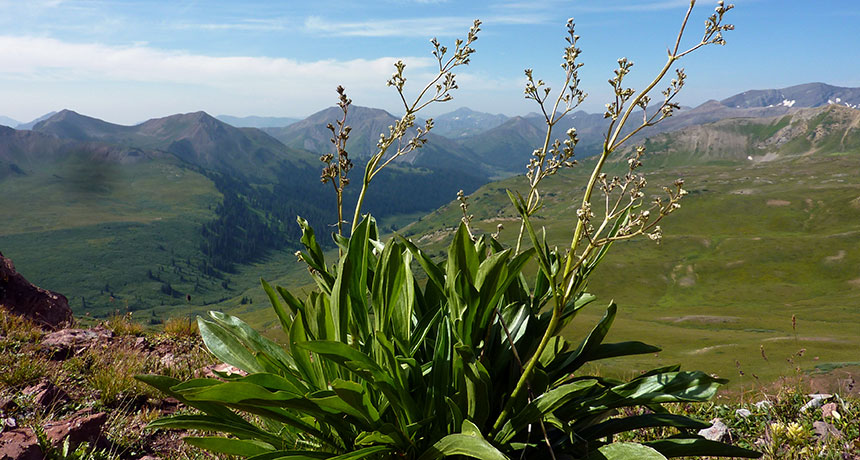Climate closing the gender gap for this mountain flower
Males move up the mountain as weather patterns warm

Male valerian plants growing at 3,790 meters (12,434 feet). These males have moved to higher elevations in response to hotter, drier weather. That has caused the ratio of males to females to climb over the last 40 years.
W. PETRY
These males can take the heat — an advantage when it comes to global warming. Called valerian plants, they sport small white flowers. One type of bloom grows on male plants, another type on female plants. And in Colorado’s Rocky Mountains, the males and females have responded differently to warmer and drier weather. That’s the finding of a new study.
Valerian (Valeriana edulis) plants grow over a wide range. Some live in hot, scrubby lowlands. Others sprout on cold mountain slopes. In each valerian patch, some plants are male and others female. The exact share of each sex varies with elevation, the new study finds. Males like it warm and dry. Females prefer it wet and cold. So the valerian patches higher up a mountain have tended to have far more females than males. Females may account for as many as eight out of every 10 plants at some upland sites.
But with climate change, warmer weather has been creeping slowly up the mountain slopes. More warm days has resulted in more males and fewer females. Such a rapid change in the share of males and females could be a signal of climate change, the researchers say.
They report their findings in the July 1 Science.
Forty years ago, scientists surveyed a number of the Rocky Mountains’ valerian populations. Around 3,000 meters (9,842 feet), one-third of them were males. This was right in the middle of the plant’s elevation range. Males are now 5.5 percent more common throughout the plants’ range. So someone hoping to find the same share of male plants today would have to hike much higher up the mountain.
“We think climate is acting almost like a filter on males and females,” says Will Petry of ETH Zurich. He’s the plant ecologist who led the study while at the University of California, Irvine. The warmer the climate, the more females it is filtering out. That filter is sweeping up mountainsides. It’s climbing upwards at a rate of 175 meters (574 feet) every decade, Petry and his team find.
Ecologists already knew that the share of male to female plants can change depending on altitude or how much water is around, says Spencer Barrett. He’s an ecologist at the University of Toronto who was not involved in the research. This new study is different. “The idea that a sex ratio is moving upslope,” he says, “nobody’s ever [seen] that before.”
Tracking the sexes
The share of male to female plants has changed at about the same pace as the local climate has since the late 1970s. Today’s winter snows are melting earlier. Summers are hotter and have less rain. That means each upslope area is drier now than it once was. Precipitation levels have moved up the slope by 133 meters (436 feet) every 10 years. Soil moisture has also moved up the mountain even faster pace — at 195 meters per decade.

So climate and the valerian plants’ sex ratios are changing in lock step. That suggests fast-changing sex ratios could help scientists understand how climate change will affect those species where sex differences depend on weather, says Tom Miller. He’s a population biologist at Rice University in Houston. He was also one of the study’s authors.
Whole species can migrate either in latitude (north versus south) or altitude or both. Researchers view these migrations as an indicator of climate change. But the plants’ sex ratios are changing much faster than a whole species is moving, Miller says. And that, he says, “might be a much more rapid fingerprint of climate change.” Scientists could use that fingerprint to predict the future health of a species’ population in the long term.
Petry and his group counted blooming male and female valerian plants. They studied them at 31 different sites around the Rocky Mountain Biological Laboratory in Crested Butte, Colo. That was in 2011. Then they compared those numbers with historical counts. Nine of those same populations had been surveyed between 1978 and 1980. As soon as Petry saw that the share of males to females had changed, he and his team started thinking about the impacts.
If one sex greatly outnumbers the other, a population might die out, says Kailen Mooney. Mooney works at UC Irvine and also took part in the new study. For instance, if females in lower altitudes died out, then there would be no flowers capable of growing seeds. Those lowland communities would then disappear as the last of the mature male plants died.
Such changing sex ratios can have a subtle effect on how scientists think about species’ migrations due to climate change, Mooney says. The geographic limits for a whole species, then, might be set by the limits of just one sex.







